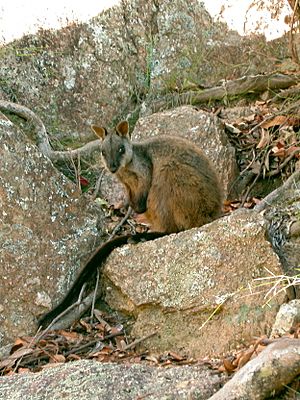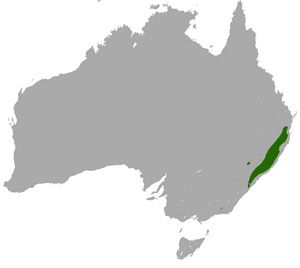Brush-tailed rock-wallaby facts for kids
Quick facts for kids Brush-tailed rock-wallaby |
|
|---|---|
 |
|
| Conservation status | |
| Scientific classification | |
| Kingdom: |
Animalia
|
| Class: | |
| Subclass: | |
| Order: | |
| Family: | |
| Genus: |
Petrogale
|
| Binomial name | |
| Petrogale penicillata (Gray, 1827)
|
|
The brush-tailed rock-wallaby (Petrogale penicillata) is a type of wallaby. It's also known as the small-eared rock-wallaby. This animal is one of several rock-wallabies found in the Petrogale group.
These wallabies live among the rocks and cliffs of Australia's Great Dividing Range. Their home stretches from about 100 kilometers (62 miles) north-west of Brisbane down to the Grampians in south-west Victoria. They like places with rainforests and dry sclerophyll forests.
Sadly, the number of brush-tailed rock-wallabies has dropped in the southern and western parts of their range. They are still common in northern New South Wales and southern Queensland. In Victoria, they are almost gone. Only four live in the Grampians National Park, and about 20 in East Gippsland. In 1988, around 80 wallabies were set free near Jenolan Caves in New South Wales. But by 1992, only seven were left.
Contents
Where Do Brush-Tailed Rock-Wallabies Live?
Brush-tailed rock-wallabies are native to Australia. They prefer rocky areas like cliffs and rocky hillsides. These places offer them shelter and protection from predators. They can be found in different types of forests, from wet rainforests to drier eucalyptus forests.
Brush-Tailed Wallabies in New Places
Sometimes, animals are moved to new places, either on purpose or by accident. This has happened with the brush-tailed rock-wallaby.
Wallabies in New Zealand
In the late 1800s, a person named Governor Grey brought brush-tailed rock-wallabies to islands in the Hauraki Gulf near Auckland, New Zealand. He also brought four other types of wallabies. These wallabies settled in very well and started having many babies.
However, over time, people realized that these wallabies were not native to New Zealand. They were causing problems for the local plants and animals. They ate too much of the native plants, which hurt the natural environment. Because of this, efforts began to remove them from the islands.
- Between 1967 and 1975, 210 rock-wallabies were caught on Kawau Island. They were then sent back to Australia. Thousands of other wallabies were also moved.
- During the 1990s, rock-wallabies were removed from Rangitoto Island and Motutapu Island.
- In the 2000s, another 33 rock-wallabies were caught on Kawau Island and returned to Australia.
Some of these wallabies from Kawau Island were moved to Waterfall Springs Conservation Park in New South Wales in 2003. This was done so they could be part of a special breeding program to help their numbers grow.
Wallabies in Hawaii
In 1916, two wallabies escaped on the island of Oahu in Hawaii. Since then, they have formed a small group that lives and breeds there.
Images for kids
See also
 In Spanish: Walabí cola de cepillo para niños
In Spanish: Walabí cola de cepillo para niños




